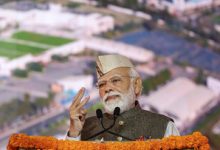Sitharaman’s ‘Economic Vaccine’ today

New Delhi, Jan 31 (PTI):
Finance Minister Nirmala Sitharaman on Monday will deliver her promised budget like no other that is expected to provide relief to the pandemic-hit common man as well as focus more on driving the economic recovery through higher spending on healthcare, infrastructure and defence amid rising tensions with neighbours.
As India emerges from the COVID-19 crisis, the ninth budget under the Modi government, including an interim one, is widely expected to focus on boosting spending on job creation and rural development, generous allocations for development schemes, putting more money in the hands of the average taxpayer and easing rules to attract foreign investments. Sitharaman, who had in her first budget in 2019 replaced leather briefcase that had been for decades used for carrying budget documents with a traditional red cloth ‘bahi-khata’, had earlier this month stated that the budget for the fiscal year beginning April will be “like never before”.
The budget, economists and experts say, will be the starting point for picking up the pieces after the economic destruction caused by the COVID-19 pandemic. And it must go beyond being just a ‘bahi khata’ or a ledger of accounts, as well as canning old schemes in a new bottle.
It has to be a vision statement, a roadmap to get the world’s fastest-growing major economy back on track.
A prescient budget, which goes a long way in instilling confidence, cannot be replaced by ‘mini-budgets’ such as the one in September 2019 when the government cut corporate tax rate just two months after Sitharaman presented her maiden one, or the periodic announcements of economic measures that dotted 2020.
There is a larger consensus among economists that the annual GDP for FY21 will decline by 7-8 per cent, one of the weakest performances among the developing nations.
The government has to play a critical role in pulling the economy out of the trough. While the pandemic is showing signs of being less virulent, a gradual progress in the vaccination programme is fuelling hope for a better future. A sustainable economic revival will need a policy catalyst. That’s where this budget assumes a special relevance.
The pandemic struck at a time when the economy was already caught in the grip of a growth slowdown. GDP growth touched an 11-year low of 4 per cent in 2019-20. A steadily declining investment rate has been a major factor in causing deceleration prior to the coronavirus crisis.
And the lockdown imposed to curb the spread of coronavirus in March last year brought economic activities to a grinding halt, causing a sharp contraction in the GDP in two successive quarters of FY21, pushing the economy into a recessionary phase.
In response, the government announced a number of policy measures under Aatmanirbhar Bharat package 1.0, 2.0 and 3.0 to support the economy. The package was a combination of grant, equity and liquidity measures by the central government, state governments and the Reserve Bank of India (RBI).
While the headline stimulus was pegged at close to Rs 21 lakh crore, the actual fiscal impact of the economic packages works out to be about Rs 3.5 lakh crore (1.8 per cent of GDP).
Also, since last budget, the size of the economy has reduced from Rs 2.24 lakh crore nominal GDP considered in the FY21 budget to Rs 1.94 lakh crore. There has been lower-than-budgeted revenue growth and higher expenditure to offset the adverse impact of the pandemic.
Among the most-watched figures in the budget would be the expenditure on vaccination in FY22 which could be shared among the central government, state governments and households.
India has started the largest vaccination programme in the world from January 16 and is using two vaccines Covishield and Covaxin.
Also, to be watched is the revenue that the government is projecting to receive from the privatisation of companies such as Bharat Petroleum (BPCL), Air India and Shipping Corporation of India (SCI).
Market borrowings are expected to remain elevated and external deficit financing would increase.
Higher capital expenditure outlay for National Infrastructure Pipeline (NIP) programme that has an aggregate investment target of Rs 111 lakh crore over the period 2020-25 and making recently introduced Production-Linked Incentive (PLI) scheme more attractive to lure foreign manufacturers to boost domestic manufacturing are top expectations from the budget.
Acuit Ratings & Research Limited said there are two primary objectives before the government at this stage reignite the growth engine in the economy while committing itself to a medium-term fiscal consolidation path.
“The growth impetus should incentivise demand in the near term and ensure its sustainability over the medium to long term.
“Four elements must be activated to build economic vibrancy over the long term – give infrastructure a significant push through public and private investments, facilitate large-scale private and foreign investments across industrial, services and agricultural sector; incentivise private consumption in the near term without significant compromises on tax revenues; and step up allocation in health and education sectors.”
Arun Singh, Global Chief Economist at Dun and Bradstreet said unprecedented circumstances require unprecedented measures.
“Globally, governments are facing massive policy and operational challenges and are adopting unconventional measures to revive their economy. A big bang package of reforms is thus on the anvil.”
Undeniably, the government has a difficult task of manoeuvring the nascent recovery of the economy and managing the fiscal burden, which is expected to remain high not only for the current year but also for the subsequent years, he said.








